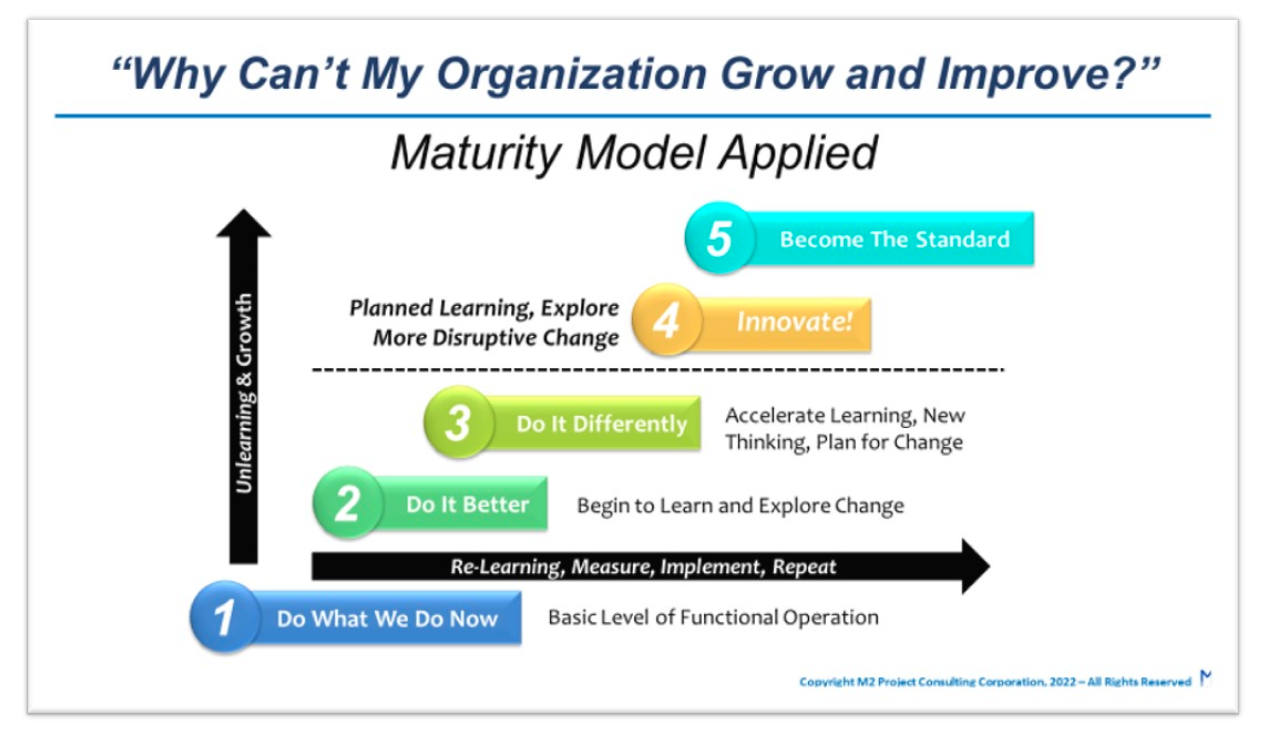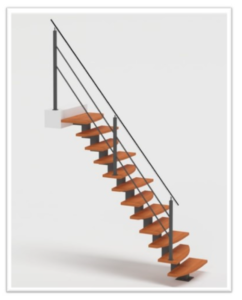 Many organizations get so caught up in what they currently do and how they do it, that they cannot find ways to effectively improve how they operate and experience the growth that stems from that kind of change. Plotting a path to organizational growth, especially based on the projects it chooses to execute, can be a challenge. The fundamental elements are not overly complicated, but the work to make the change is hard.
Many organizations get so caught up in what they currently do and how they do it, that they cannot find ways to effectively improve how they operate and experience the growth that stems from that kind of change. Plotting a path to organizational growth, especially based on the projects it chooses to execute, can be a challenge. The fundamental elements are not overly complicated, but the work to make the change is hard.
Stripping back the veneer of “pretend change” and finding how execution Value comes from properly communicated Vision and choices rooted in those fundamental elements often takes fresh eyes and a willingness to do things in a very different way. It can be a bit unnerving, but the alternative is stagnation.
 Through this series of articles, we’ll highlight and discuss some of the fundamental elements that are necessary to effect real growth and improvement that is sustainable, and weed out the things that only add noise and distraction.
Through this series of articles, we’ll highlight and discuss some of the fundamental elements that are necessary to effect real growth and improvement that is sustainable, and weed out the things that only add noise and distraction.
Ascending the Simplified Maturity Model “Stairs”
We introduced this highly simplified maturity model in the last article and noted that, while it does resemble the CMMI model, it’s heavily “dumbed down” for the rest of us. This week, we’ll discuss some of the steps in the process of moving up the levels and how the choice to change plays into the equation.
Beginning at the Beginning
For organizations content with operating at the most basic, functional level (Level 1) who choose not to change, the model isn’t really relevant. That’s why, in the image above, we’ve placed that level below both of the axis lines. If you aren’t intending to drive toward substantive growth and improvement, it doesn’t make any sense (and you can probably stop reading now). All in all, that position is fine for many organizations and individuals. And there’s nothing wrong with that choice at all.
 But, if your goal is to move upward and forward, you have to begin thinking about the steps you’ll need to take to get to Level 2 (the Practically Functional entity) or even Level 3 (the Progressively Functional entity). In considering your next move, you’ll need to evaluate your current state and choose to leave behind much of the baggage you’ve accumulated. You’ll need to embrace a concept that is somewhat foreign by nature. That concept is the act of “UN-Learning” and it will serve as the foundation for everything else you plan out and do in your journey up the maturity stairway. As Einstein once said, “We cannot solve our problems with the same thinking we used when we created them.”
But, if your goal is to move upward and forward, you have to begin thinking about the steps you’ll need to take to get to Level 2 (the Practically Functional entity) or even Level 3 (the Progressively Functional entity). In considering your next move, you’ll need to evaluate your current state and choose to leave behind much of the baggage you’ve accumulated. You’ll need to embrace a concept that is somewhat foreign by nature. That concept is the act of “UN-Learning” and it will serve as the foundation for everything else you plan out and do in your journey up the maturity stairway. As Einstein once said, “We cannot solve our problems with the same thinking we used when we created them.”
To Unlearn is to take aim at the things you are doing now that aren’t working anymore or at least not working the way you need them to work to foster organizational growth and sustainable change. It can be a challenge because (as we pointed out in a previous article), the “Status Quo” is often the number one competitor you face. Frankly, inertia feels safer to most of us. It requires less effort (though it produces less in terms of results). And nobody is going to come along and second guess you for holding the line and doing what you’ve always done. They’re also not going to reward you and the change you know you need will remain somewhere in the distance. To paraphrase Peter Drucker, you’ll need to focus on the unlearning/relearning tandem that shows you what you need to stop doing as much as what you need to do different in the future.
Mounting an Expedition
If you are committed to the change you know you need, and you are willing to embark on the journey that starts with unlearning your past, then what lies ahead can be considered an “expedition”. Some of it will be trial and error; some of it will follow a little more prescriptive path. Ultimately, once you’ve begun the unlearning process, you need to refill the gaps with new learning, or perhaps we should term it “RE-learning” in a way that doesn’t repeat the mistakes of the past.
The exploration and commitment to relearning the right way will serve as your guides on the pathway to growth, improvement, and substantial change. It won’t necessarily be easy (remember, we said that in the first article – change is often hard), but you aren’t after something so complicated that it will just frustrate your efforts and cause you to abandon your quest to improve. Most changes need to be incremental, determining what metrics show you the truth and which ones just add to the noise you are trying to leave behind. Your path will most likely look very different from that of your peer organizations, but remember you are not trying to emulate them (unless they are that Level 5 unicorn). You’re trying to learn and move forward in a way that suits your needs.
Once you’ve gone through a few cycles of the Unlearn-Explore-Relearn-Change process, you’ll find it easier to navigate and you can begin to plot out your course for more substantive changes. The way you think about your operation and growth will evolve and become more efficient. At this point, you can begin to accelerate learning and pro-actively plan for change. If you refer back to the maturity model graphic above, you should now see the reason we placed Levels 4 and 5 above the dotted line. And, to be perfectly candid, many companies settle in at Level 3 and do extremely well.
Dangerous Curves Ahead
If you have the fortitude and commitment (not to mention the need), you can take this all the way to the higher levels. Doing so will invite a kind of disruption that goes far beyond the normal buzzword and “sexy term” use of the word. It will evoke the kind of planned, intentional disruption that leaves the old status quo far behind and never looks back. Even the lower levels of organizations can plan out some amount of disruption, b ut to sustain it and plan for it pretty much requires an organization that is extremely adept at seeking change and plotting the most effective course to that destination. If you can make that a repeatable process in your organization, you are well on the way to the highest levels of maturity and have the kind of sustainable growth and improvement in your sights that others only dream about. Maybe you can even lasso and ride that unicorn …
ut to sustain it and plan for it pretty much requires an organization that is extremely adept at seeking change and plotting the most effective course to that destination. If you can make that a repeatable process in your organization, you are well on the way to the highest levels of maturity and have the kind of sustainable growth and improvement in your sights that others only dream about. Maybe you can even lasso and ride that unicorn …
The classic business school growth chart normally shows an angular pattern with slanted slopes or arcs. That’s a factor of collecting data points, plotting them out, and then connecting the dots. It’s great for the type of chart it is, but it doesn’t really tell the story of organizational growth in an adequate way.
Referring once again to the graphic above, there is a reason we used the stair step model. The growth you are after doesn’t come in slopes and curves. It comes in a stair step pattern where you work on a set of parameters, invest time, money, and effort to climb up a level, and you evaluate your position (and maybe take a rest). The end goal is always out there, and you refine your actions and metrics along the way, but you don’t just glide up in one easy motion (or at least most organizations and individuals don’t). You work at it, often step by step.
Last year, we made a trip to Western North Carolina and decided to invest the effort to see Mingo Falls (just outside of Cherokee). The image we use in our lead-in title slide is of Mingo Falls. It’s about 160 hard-fought, uneven steps to the bridge where you can see that view and hear the water. There are some level portions and benches along the way so you can pace yourself. The final ten steps or so are very steep and challenging. But the view, as represented in the picture, is well worth the effort. It wasn’t complicated to get there … but it was hard (harder in some places than others).
But Wait! There’s More!
We’ve briefly discussed the application of the simplified organizational maturity model and how progressing through the various levels will take some concentrated effort and new, fresh approaches. The concept of UN-learning is critical, as is the fact that you won’t reach the top in one step or without hard work. The right change will breed more change. But you have to leave the status quo and inertia behind.
In the next article, we’ll introduce four pillars to consider when seeking organizational change. Some of the concepts will be familiar. None of them will be complicated. All of them will require effort and commitment.
Bio
Mark Moore, M2PCC’s Executive Consultant, is an experienced leader and communicator, with a long track record of successful program and project management, training development and delivery, and transformational change. He brings over three decades of experience spanning multiple industries and disciplines. His focus on delivery of Value aligned with Vision lies at the heart of FLOW and organizational transformation.
Executive Consultant
mark@m2projectconsultingcorp.com
919.724.3679
